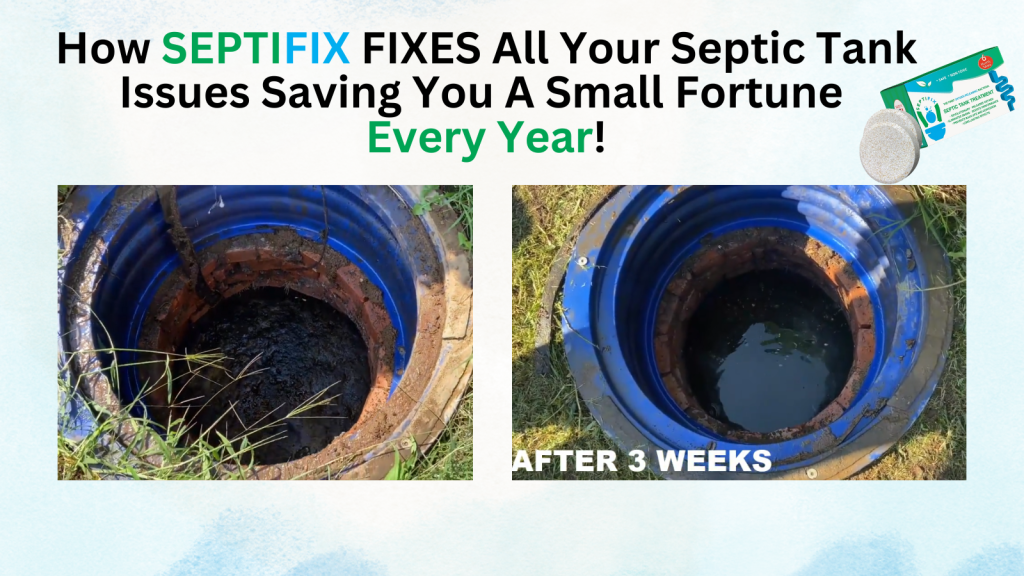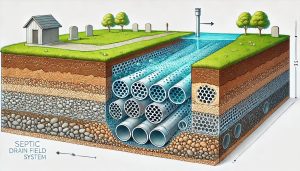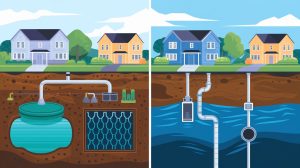Septic systems play a vital role in managing wastewater for homes and businesses, especially in areas without access to centralized sewer systems. However, septic regulations by state vary significantly across the United States, making it essential for property owners to understand their state’s specific requirements.
This guide breaks down septic regulations by state, helping you navigate permit requirements, inspection intervals, and maintenance guidelines. Whether you’re installing a new system or maintaining an existing one, staying compliant ensures environmental safety and prevents costly fines. Keep reading to explore everything you need to know about septic regulations in your state.
Table of Contents
- Overview of Septic Regulations
- Federal Guidelines and Their Influence on States
- Expanded State-by-State Breakdown
- Special Considerations and Challenges in Septic Regulations
- Septic Permit Links by State
Overview of Septic Regulations
Septic regulations ensure wastewater systems operate safely and efficiently, protecting public health and the environment. These rules govern the installation, inspection, and maintenance of septic systems and often vary by state, county, or municipality.
At their core, septic regulations aim to:
- Protect Groundwater: Prevent contamination of drinking water sources.
- Safeguard Public Health: Minimize exposure to untreated wastewater.
- Preserve Ecosystems: Reduce the impact of wastewater on nearby rivers, lakes, and wetlands.
While federal guidelines, such as those from the Environmental Protection Agency (EPA), provide a baseline for septic system management, individual states often have more specific requirements tailored to their unique environmental and geographic needs.
Understanding these regulations is critical for homeowners, businesses, and developers. Failure to comply can lead to fines, system failures, or costly repairs. In the next sections, we’ll explore how federal laws influence state regulations and provide a detailed breakdown of rules across the U.S.
Would you like me to continue with the section on federal guidelines?
Federal Guidelines and Their Influence on States
Federal guidelines, primarily established by the Environmental Protection Agency (EPA), provide a foundational framework for managing septic systems across the United States. While these guidelines are not laws, they serve as recommendations that states often adapt to create their own regulations.
Key Aspects of Federal Guidelines
- Design Standards: Recommendations for septic system design to ensure proper wastewater treatment.
- Maintenance Practices: Guidance on regular pumping, inspections, and repairs to extend system life.
- Environmental Protection: Emphasis on preventing contamination of groundwater, rivers, and other water sources.
How States Adapt Federal Guidelines
Each state interprets and implements these federal recommendations differently, tailoring them to their environmental conditions and public health needs. For example:
- Coastal States like Florida and California often impose stricter rules to protect sensitive ecosystems.
- Rural States such as Montana or Wyoming may offer more lenient regulations due to lower population density.
Federal Funding and Support
The EPA also provides funding and resources to help states enforce septic regulations. Programs like the Clean Water State Revolving Fund (CWSRF) offer financial assistance for septic system upgrades, particularly in underserved communities.
By understanding the influence of federal guidelines, property owners can better appreciate the rationale behind their state’s specific requirements. Next, we’ll dive into the state-by-state breakdown of septic regulations.
Expanded State-by-State Breakdown
Septic Regulations State of California
- Permit Requirements: California requires permits for all new septic system installations and significant repairs. Coastal areas and environmentally sensitive zones, such as near wetlands or protected habitats, have additional restrictions to prevent groundwater contamination.
- Inspection Frequency: Annual inspections are mandatory in areas with a high risk of environmental impact, such as those near water bodies or in earthquake-prone regions where soil shifts could affect system integrity.
- Special Considerations: In areas like Los Angeles and San Francisco counties, advanced treatment systems that reduce nitrogen and other pollutants are often required to meet strict environmental standards.
Septic Regulations State of Texas
- Permit Process: In Texas, local authorities issue septic system permits, with rules varying by county. Urban areas often have stricter guidelines than rural regions. Systems serving more than one household may require additional approval.
- Maintenance Rules: Aerobic septic systems, common in Texas due to its clay-heavy soils, must have a maintenance contract with a licensed service provider. This ensures proper functionality and compliance with state regulations.
- Regional Variations: In regions like the Hill Country, additional soil testing and system designs protect karst aquifers, which are highly susceptible to contamination.
Septic Regulations State of Florida
- Environmental Focus: Florida’s septic regulations prioritize the protection of its vast wetlands and coastal areas. Properties near these sensitive ecosystems often require advanced nutrient-reducing systems to prevent algae blooms and water pollution.
- Inspection Rules: All septic systems must be inspected at least once every five years, with more frequent checks required in high-risk zones.
- Advanced Systems: Homes near springs or in areas like the Florida Keys are required to install systems with enhanced treatment capabilities to reduce nitrogen discharge.
Septic Regulations State of Colorado
- Permit Requirements: Colorado mandates permits for all new septic system installations and major modifications. Local health departments oversee the permitting process, ensuring compliance with both state and county regulations.
- Soil Testing: A percolation test is required to determine if the soil can absorb wastewater effectively. This is especially critical in mountainous regions where rocky terrain can complicate system design.
- Inspection Rules: Inspectors require property transfers or major renovations to ensure systems function correctly and meet current standards.
Septic Regulations State of Michigan
- Local Control: Michigan does not have a statewide septic code, leaving regulations to individual counties. This means requirements can vary significantly depending on location.
- Inspection Frequency: Some counties, particularly those near the Great Lakes, require septic inspections during property transactions to prevent environmental contamination.
- Environmental Protection: Regulations often focus on protecting Michigan’s extensive freshwater resources, with additional rules for systems near lakes, rivers, and wetlands.
Septic Regulations State of Tennessee
- Permit Process: Tennessee requires permits for all new installations and modifications. The state’s Department of Environment and Conservation oversees septic regulations, ensuring systems meet safety and environmental standards.
- Maintenance Guidelines: While regular pumping is strongly recommended, it is not universally enforced. Homeowners should maintain systems to prevent failures.
- Geographic Variations: Mountainous regions in Tennessee may require specialized system designs to account for steep slopes and rocky soils, whereas flat areas may have fewer restrictions.
Septic Regulations State of Maine
- Permit Requirements: Permits are required for all new septic installations and repairs in Maine. The state’s Subsurface Wastewater Disposal Rules outline specific criteria for system design and placement.
- Seasonal Challenges: Maine’s harsh winters necessitate systems designed to withstand freezing temperatures. Leach fields must stay deep enough to prevent frost penetration.
- Environmental Focus: Additional protections are in place for properties near lakes, rivers, and coastal areas to prevent pollution and preserve water quality.
Septic Regulations State of Vermont
- Permit Process: Vermont has strict statewide regulations requiring permits for all septic systems. The Agency of Natural Resources oversees these rules, ensuring compliance with environmental standards.
- Inspection Frequency: Regular inspections are highly recommended, especially for older systems, to prevent failures that could damage the state’s natural environment.
- Environmental Emphasis: Vermont places a strong emphasis on protecting water quality, especially in rural and agricultural areas where improper septic management could impact streams and groundwater.
Septic Regulations State of Alabama
- Inspection Rules: Inspections are not universally mandated, but they are often required during property sales or when modifying existing systems.
- Permit Requirements: Alabama requires permits for all new septic system installations and repairs. Local health departments manage the permitting process, ensuring systems meet state guidelines.
- Soil Testing: A soil percolation test is mandatory to determine the land’s suitability for a septic system. Areas with heavy clay soil may require alternative system designs.
Septic Regulations State of New York
- Permit Process: In New York, all new septic system installations and significant repairs require permits issued by local health departments. Regulations vary between urban and rural areas, with stricter rules in regions near protected watersheds like the Catskills and Adirondacks.
- Inspection Frequency: Although statewide mandates for regular inspections are limited, many counties require inspections during property sales to ensure local compliance.
- Environmental Concerns: Septic systems near reservoirs, such as those supplying New York City’s water, must meet rigorous treatment standards to prevent contamination. These zones may require advanced systems.
Montana
- Inspection Rules: Inspections are less frequent in Montana’s remote regions but are highly recommended during property transfers to identify potential issues.
- Local Regulations: Montana’s septic regulations are primarily managed at the county level, allowing for flexibility based on local environmental conditions. However, the state provides overarching guidelines to ensure consistency.
- Permit Requirements: Permits are required for all new systems and significant repairs, with emphasis on protecting groundwater resources in rural areas.
Special Considerations and Challenges in Septic Regulations
Environmental Protection
One of the primary goals of septic regulations is to protect the environment, particularly groundwater and surface water. Many states have implemented strict rules to prevent contamination from failing or improperly maintained septic systems. This is especially crucial in areas where the water supply relies on groundwater, such as rural communities and farming regions.
- Coastal Areas: States like Florida, California, and Maine have additional regulations for septic systems located near coastal areas. These systems must meet higher standards to prevent pollutants, such as nitrates and phosphorus, from contaminating sensitive ecosystems like estuaries and coral reefs.
- Water Bodies and Wetlands: Many states, including Michigan, New York, and Vermont, require advanced treatment systems for properties near lakes, rivers, or wetlands. These areas are highly vulnerable to contamination from untreated or improperly treated wastewater, which can lead to water quality issues, such as harmful algal blooms.
Soil and Terrain Considerations
Soil composition plays a critical role in septic system design and performance. States with diverse geographical features, such as Colorado, Tennessee, and Montana, have regulations tailored to different soil types. For example:
- Rocky and Clay Soils: In Colorado and Tennessee, areas with rocky or clay-heavy soils require specialized septic systems that can handle poor water absorption. These areas may require alternative designs like aerobic treatment units or mound systems to ensure proper wastewater filtration and prevent surface runoff.
- Mountainous Regions: In Montana and Tennessee, mountainous terrain presents unique challenges for septic system installation. Designs must account for steep slopes and the risk of soil erosion, which can affect system stability and wastewater treatment.
Technological Advancements and New Regulations
As technology advances, many states are updating their septic regulations to incorporate new, more efficient systems. These systems treat wastewater more effectively, reduce environmental impact, and extend the lifespan of septic systems.
- Advanced Treatment Systems: In states like Florida, California, and Alabama, advanced systems that treat wastewater to higher standards are often required in sensitive areas. These systems include aerobic treatment units, which add oxygen to the treatment process, and nitrogen-reducing systems that help prevent nutrient pollution in water bodies.
- Monitoring and Maintenance Technology: New technologies, such as remote monitoring systems, allow homeowners and local authorities to track septic system performance in real time. This can help prevent failures before they cause significant environmental damage. States like Texas and Michigan are incorporating new technologies into regulations to enhance system maintenance and reduce failures.
Cost and Affordability of Septic Systems
The cost of installing and maintaining a septic system can vary significantly depending on the state, location, and system type. States with higher costs of living, like California and New York, often have more expensive septic systems due to stricter regulations and higher labor costs.
Rural areas in states like Alabama and Montana offer more affordable options, but still require compliance with basic environmental standards.
- Financial Assistance: Some states offer financial assistance programs or low-interest loans to help homeowners cover the costs of septic system installation or repair. For example, Maine and Vermont provide funding for septic system upgrades in rural or low-income areas.
- Cost-Saving Measures: Homeowners in states like Texas and Tennessee can save money by opting for basic systems that meet local regulations, but they must still ensure proper maintenance to avoid costly repairs down the road.
Septic Regulations and Property Value
Septic system compliance can also affect property values. In many states, homebuyers are concerned about a property’s septic system, especially in rural areas without municipal sewage systems.
- Property Transfers: States like Colorado and Michigan require septic inspections during property transfers to ensure systems are functioning properly. Homes with outdated or non-compliant septic systems may face lower market values or be harder to sell.
- Upgrades and Resale Value: Investing in an advanced septic system or upgrading an old system can increase a property’s resale value, especially in areas where septic system compliance is strictly enforced.
Conclusion: Navigating Septic Regulations Across States
Septic regulations vary by state, adapting to local environmental concerns, soil types, and population density. Understanding septic regulations helps homeowners and buyers ensure compliance, protect the environment, and maintain system functionality.
Whether you’re installing a new system in California, maintaining an existing one in Tennessee, or buying property in Maine, it’s essential to familiarize yourself with the specific requirements in your state. Regular inspections, proper maintenance, and the use of advanced treatment technologies can help prevent costly repairs and environmental harm.
Septic Regulations in Rural Areas: Essential Guide for Rural Property Owners
The Role of Perforated Pipes in Drain Fields
What Happens During a Pumping Service?
Septic Tanks vs. Sewer Systems | Choosing the Right Option
Directory | Virginia Septic Service Providers | Part 2
Directory | Virginia Septic Service Providers : Best Professionals | Part 1
Septic Treatments for Odor Control: Best Methods for Eliminating Unpleasant Smells
How to Maintain a Healthy Bacteria Balance | Tips to Ensure Your Septic System Has the Right Microbial Environment









